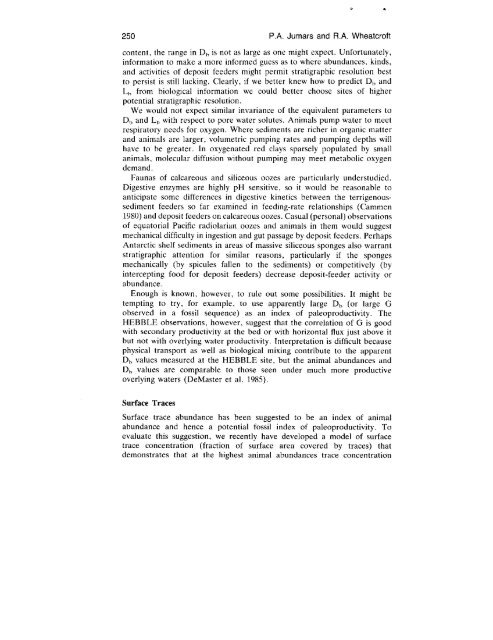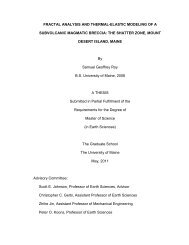Responses of Benthos to Changing Food Quality and Quantity, with ...
Responses of Benthos to Changing Food Quality and Quantity, with ...
Responses of Benthos to Changing Food Quality and Quantity, with ...
Create successful ePaper yourself
Turn your PDF publications into a flip-book with our unique Google optimized e-Paper software.
250 P .A . Jumars <strong>and</strong> R .A . Wheatcr<strong>of</strong>t<br />
content, the range in D„ is not as large as one might expect . Unfortunately,<br />
information <strong>to</strong> make a more informed guess as <strong>to</strong> where abundances, kinds,<br />
<strong>and</strong> activities <strong>of</strong> deposit feeders might permit stratigraphic resolution best<br />
<strong>to</strong> persist is still lacking . Clearly, if we better knew how <strong>to</strong> predict D,, <strong>and</strong><br />
L,, from biological information we could better choose sites <strong>of</strong> higher<br />
potential stratigraphic resolution .<br />
We would not expect similar invariance <strong>of</strong> the equivalent parameters <strong>to</strong><br />
D„ <strong>and</strong> L„ <strong>with</strong> respect <strong>to</strong> pore water solutes . Animals pump water <strong>to</strong> meet<br />
respira<strong>to</strong>ry needs for oxygen . Where sediments are richer in organic matter<br />
<strong>and</strong> animals are larger, volumetric pumping rates <strong>and</strong> pumping depths will<br />
have <strong>to</strong> be greater . In oxygenated red clays sparsely populated by small<br />
animals, molecular diffusion <strong>with</strong>out pumping may meet metabolic oxygen<br />
dem<strong>and</strong> .<br />
Faunas <strong>of</strong> calcareous <strong>and</strong> siliceous oozes are particularly understudied .<br />
Digestive enzymes are highly pH sensitive, so it would be reasonable <strong>to</strong><br />
anticipate some differences in digestive kinetics between the terrigenoussediment<br />
feeders so far examined in feeding-rate relationships (Cammen<br />
1980) <strong>and</strong> deposit feeders on calcareous oozes . Casual (personal) observations<br />
<strong>of</strong> equa<strong>to</strong>rial Pacific radiolarian oozes <strong>and</strong> animals in them would suggest<br />
mechanical difficulty in ingestion <strong>and</strong> gut passage by deposit feeders . Perhaps<br />
Antarctic shelf sediments in areas <strong>of</strong> massive siliceous sponges also warrant<br />
stratigraphic attention for similar reasons, particularly if the sponges<br />
mechanically (by spicules fallen <strong>to</strong> the sediments) or competitively (by<br />
intercepting food for deposit feeders) decrease deposit-feeder activity or<br />
abundance .<br />
Enough is known, however, <strong>to</strong> rule out some possibilities . It might be<br />
tempting <strong>to</strong> try, for example, <strong>to</strong> use apparently large D„ (or large G<br />
observed in a fossil sequence) as an index <strong>of</strong> paleoproductivity . The<br />
HEBBLE observations, however, suggest that the correlation <strong>of</strong> G is good<br />
<strong>with</strong> secondary productivity at the bed or <strong>with</strong> horizontal flux just above it<br />
but not <strong>with</strong> overlying water productivity . Interpretation is difficult because<br />
physical transport as well as biological mixing contribute <strong>to</strong> the apparent<br />
De values measured at the HEBBLE site, but the animal abundances <strong>and</strong><br />
D,, values are comparable <strong>to</strong> those seen under much more productive<br />
overlying waters (DeMaster et al . 1985) .<br />
Surface Traces<br />
Surface trace abundance has been suggested <strong>to</strong> be an index <strong>of</strong> animal<br />
abundance <strong>and</strong> hence a potential fossil index <strong>of</strong> paleoproductivity . To<br />
evaluate this suggestion, we recently have developed a model <strong>of</strong> surface<br />
trace concentration (fraction <strong>of</strong> surface area covered by traces) that<br />
demonstrates that at the highest animal abundances trace concentration
















